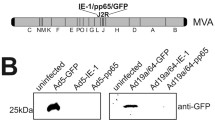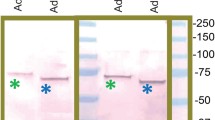Abstract
Recombinant adenoviral vectors (AdV) are potent vehicles for antigen engineering of dendritic cells (DC). DC engineered with AdV to express full length tumor antigens are capable stimulators of antigen-specific polyclonal CD8+ and CD4+ T cells. To determine the impact of AdV on the HLA class I antigen presentation pathway, we investigated the effects of AdV transduction on antigen processing machinery (APM) components in human DC. Interactions among AdV transduction, maturation, APM regulation and T cell activation were investigated. The phenotype and cytokine profile of DC transduced with AdV was intermediate, between immature (iDC) and matured DC (mDC). Statistically significant increases in expression were observed for peptide transporters TAP-1 and TAP-2, and HLA class I peptide-loading chaperone ERp57, as well as co-stimulatory surface molecule CD86 due to AdV transduction. AdV transduction enhanced the expression of APM components and surface markers on mDC, and these changes were further modulated by the timing of DC maturation. Engineering of matured DC to express a tumor-associated antigen stimulated a broader repertoire of CD8+ T cells, capable of recognizing immunodominant and subdominant epitopes. These data identify molecular changes in AdV-transduced DC (AdV/DC) that could influence T cell priming and should be considered in design of cancer vaccines.








Similar content being viewed by others
References
Arthur JF et al (1997) A comparison of gene transfer methods in human dendritic cells. Cancer Gene Ther 4(1):17–25
Butterfield LH et al (1998) Generation of melanoma-specific cytotoxic T lymphocytes by dendritic cells transduced with a MART-1 adenovirus. J Immunol 161(10):5607–5613
Diao J et al (1999) Human PBMC-derived dendritic cells transduced with an adenovirus vectorinduce cytotoxic T-lymphocyte responses against a vector-encoded antigen in vitro. Gene Ther 6(5):845–853
Lundqvist A et al (2002) Recombinant adenovirus vector activates and protects human monocyte-derived dendritic cells from apoptosis. Hum Gene Ther 13(13):1541–1549
Schumacher L et al (2004) Human dendritic cell maturation by adenovirus transduction enhances tumor antigen-specific T-cell responses. J Immunother 27(3):191–200
Perreau M et al (2007) Contrasting effects of human, canine, and hybrid adenovirus vectors on the phenotypical and functional maturation of human dendritic cells: implications for clinical efficacy. J Virol 81(7):3272–3284
Tan PH et al (2005) Immunolipoplexes: an efficient, nonviral alternative for transfection of human dendritic cells with potential for clinical vaccination. Mol Ther 11(5):790–800
He Y et al (2005) Immunization with lentiviral vector-transduced dendritic cells induces strong and long-lasting T cell responses and therapeutic immunity. J Immunol 174(6):3808–3817
Metharom P, Ellem KA, Wei MQ (2005) Gene transfer to dendritic cells induced a protective immunity against melanoma. Cell Mol Immunol 2(4):281–288
Nakamura M et al (2005) Dendritic cells transduced with tumor-associated antigen gene elicit potent therapeutic antitumor immunity: comparison with immunodominant peptide-pulsed DCs. Oncology 68(2–3):163–170
Yuan J et al (2005) Langerhans cells derived from genetically modified human CD34+ hemopoietic progenitors are more potent than peptide-pulsed Langerhans cells for inducing antigen-specific CD8+ cytolytic T lymphocyte responses. J Immunol 174(2):758–766
Curti A et al (2005) Interleukin-12 production by leukemia-derived dendritic cells counteracts the inhibitory effect of leukemic microenvironment on T cells. Exp Hematol 33(12):1521–1530
Lotem M et al (2006) Presentation of tumor antigens by dendritic cells genetically modified with viral and nonviral vectors. J Immunother (1997) 29(6):616–627
van Leeuwen EB et al (2006) Transduction with a fiber-modified adenoviral vector is superior to non-viral nucleofection for expressing tumor-associated Ag mucin-1 in human DC. Cytotherapy 8(1):36–46
Liu Y et al (2006) Hierarchy of AFP-specific T cell responses in subjects with AFP-positive hepatocellular cancer. J Immunol 177(1):712–721
Evdokimova VN et al (2007) AFP-specific CD4+ helper T-cell responses in healthy donors and HCC patients. J Immunother 30(4):425–437
Koch J, Tampe R (2006) The macromolecular peptide-loading complex in MHC class I-dependent antigen presentation. Cell Mol Life Sci 63:653–662
Mishito M et al (2003) Immunoproteasomes and immunosenescence. Ageing Res Rev 2:419–432
Connolly N et al (2007) Levels of antigen processing machinery components in dendritic cells generated for vaccination of HIV-1+ subjects. Aids 21(13):1683–1692
Whiteside TL et al (2004) Antigen-processing machinery in human dendritic cells: up-regulation by maturation and down-regulation by tumor cells. J Immunol 173(3):1526–1534
Tourkova IL et al (2005) Restoration by IL-15 of MHC class I antigen-processing machinery in human dendritic cells inhibited by tumor-derived gangliosides. J Immunol 175(5):3045–3052
Callahan MK et al (2006) Heat shock up-regulates lmp2 and lmp7 and enhances presentation of immunoproteasome-dependent epitopes. J Immunol 177(12):8393–8399
Obeid M et al (2007) Calreticulin exposure dictates the immunogenicity of cancer cell death. Nat Med 13(1):54–61
Meissner M et al (2005) Defects in the human leukocyte antigen class I antigen processing machinery in head and neck squamous cell carcinoma: association with clinical outcome. Clin Cancer Res 11(7):2552–2560
Butterfield LH et al (1999) Generation of human T-cell responses to an HLA-A2.1-restricted peptide epitope derived from alpha-fetoprotein. Cancer Res 59(13):3134–3142
Bandoh N et al (2005) Development and characterization of human constitutive proteasome and immunoproteasome subunit-specific monoclonal antibodies. Tissue Antigens 66(3):185–194
Ogino T et al (2003) Association of tapasin and HLA class I antigen down-regulation in primary maxillary sinus squamous cell carcinoma lesions with reduced survival of patients. Clin Cancer Res 9(11):4043–4051
Wang X et al (2005) A method to generate antigen-specific mAb capable of staining formalin-fixed, paraffin-embedded tissue sections. J Immunol Methods 299(1–2):139–151
Tatsumi T et al (2003) MAGE-6 encodes HLA-DRbeta1*0401-presented epitopes recognized by CD4+ T cells from patients with melanoma or renal cell carcinoma. Clin Cancer Res 9(3):947–954
Tatsumi T et al (2002) Disease-associated bias in T helper type 1 (Th1)/Th2 CD4(+) T cell responses against MAGE-6 in HLA-DRB10401(+) patients with renal cell carcinoma or melanoma. J Exp Med 196(5):619–628
Philpott NJ et al (2004) Adenovirus-induced maturation of dendritic cells through a PI3 kinase-mediated TNF-alpha induction pathway. Proc Natl Acad Sci USA 101(16):6200–6205
Vujanovic L et al (2007) A mycoplasma peptide elicits heteroclitic CD4+ T cell responses against tumor antigen MAGE-A6. Clin Cancer Res 13(22 pt 1):6796–6806
Vujanovic L et al (2006) IL-12p70 and IL-18 gene-modified dendritic cells loaded with tumor antigen-derived peptides or recombinant protein effectively stimulate specific Type-1 CD4+ T-cell responses from normal donors and melanoma patients in vitro. Cancer Gene Ther 13(8):798–805
Butterfield LH et al (2001) T cell responses to HLA-A*0201-restricted peptides derived from human alpha fetoprotein. J Immunol 166(8):5300–5308
Stager S, Kaye PM (2004) CD8+ T-cell priming regulated by cytokines of the innate immune system. Trends Mol Med 10(8):366–371
Lowes MA et al (1997) T helper 1 cytokine mRNA is increased in spontaneously regressing primary melanoma. J Invest Derm 108:914–919
Schwaab T et al (2000) A randomized phase II trial comparing two different sequence combinations of autologous vaccine and human recombinant interferon gamma and human recombinant interferon alpha2B therapy in patients with metastatic renal cell carcinoma: clinical outcome and analysis of immunological parameters. J Urol 163:1322–1327
Ahn HJ et al (1997) A mechanism underlying synergy between IL-12 and IFN-gamma-inducing factor in enhanced production of IFN-gamma. J Immunol 159:2125–2131
Rogers NJ et al (2003) Cross-species costimulation: relative contributions of CD80, CD86, and CD40. Transplant 75(12):2068–2076
Rogers NJ et al (2003) CD40 can costimulate human memory T cells and favors IL-10 secretion. Eur J Immunol 33:1094–1104
Fields PE et al (1998) B7.1 is a quantitatively stronger costimulus than B7.2 in the activation of naive CD8+ TCR-transgenic T cells. J Immunol 161:5268–5275
Manzotti CN et al (2006) Integration of CD28 and CTLA-4 Function Results in Differential Responses of T Cells to CD80 and CD86. Eur J Immunol 36:1413–1422
Kienast A et al (2007) Redox regulation of peptide receptivity of major histocompatibility complex class I molecules by ERp57 and tapasin. Nat Immunol 8:864–872
Wearsch PA, Cresswell P (2007) Selective loading of high-affinity peptides onto major histocompatibility complex class I molecules by the tapasin-ERp57 heterodimer. Nat Immunol 8:873–881
Fruh K et al (1994) Displacement of housekeeping proteasome subunits by MHC-encoded LMPs: a newly discovered mechanism for modulating the multicatalytic proteinase complex. EMBO J 13:3236–3244
Gaczynska M et al (1996) Proteasome subunits X and Y alter peptidase activities in opposite ways to the interferon-γ-induced subunits LMP2 and LMP7. J Biol Chem 271:17275–17280
Gaczynska M et al (1994) Peptidase activities of proteasomes are differentially regulated by the major histocompatibility complex-encoded genes for LMP2 and LMP7. Proc Natl Acad Sci USA 91:9213–9217
Schwarz K et al (2000) Overexpression of the proteasome subunits LMP2, LMP7, and MECL-1, but not PA28 α/β, enhances the presentation of an immunodominant lymphocytic choriomeningitis virus T cell epitope. J Immunol 165:768–778
Sijts AJAM et al (2000) MHC class I antigen processing of an adenovirus CTL epitope is linked to the levels of immunoproteasomes in infected cells. J Immunol 164:4500–4506
Macagno A et al (2001) Pronounced up-regulation of the PA28α/β proteasome regulator but little increase in the steady-state content of immunoproteasome during dendritic cell maturation. Eur J Immunol 31:3271–3280
Marques L et al (2004) STAT1 regulates lipopolysaccharide- and TNF-alpha-dependent expression of transporter associated with antigen processing 1 and low molecular mass polypeptide 2 genes in macrophages by distinct mechanisms. J Immunol 173(2):1103–1110
Li J et al (2001) Bipartite regulation of different components of the MHC class I antigen-processing machinery during dendritic cell maturation. Int Immunol 13(12):1515–1523
Macagno A et al (1999) Dendritic cells up-regulate immunoproteasomes and the proteasome regulator PA28 during maturation. Eur J Immunol 29:4037–4042
Cheng C et al (2007) Mechanism of ad5 vaccine immunity and toxicity: fiber shaft targeting of dendritic cells. PLoS Pathog 3(2):e25
Acknowledgments
This work was supported by the University of Pittsburgh Cancer Institute and the Henry L. Hillman Foundation (LHB).
Author information
Authors and Affiliations
Corresponding author
Rights and permissions
About this article
Cite this article
Vujanovic, L., Whiteside, T.L., Potter, D.M. et al. Regulation of antigen presentation machinery in human dendritic cells by recombinant adenovirus. Cancer Immunol Immunother 58, 121–133 (2009). https://doi.org/10.1007/s00262-008-0533-2
Received:
Accepted:
Published:
Issue Date:
DOI: https://doi.org/10.1007/s00262-008-0533-2




